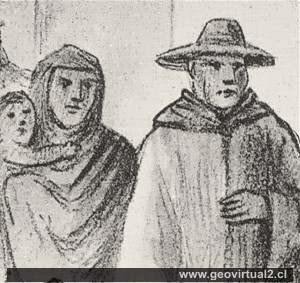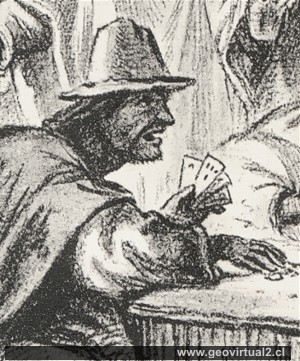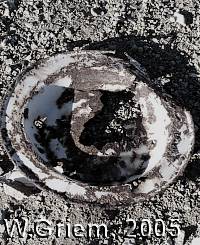Paul Treutler
Content
Pictures
Annotations
Text of Treutler
---
page +

From: Treutler (1882)
Todas las caras del dibujo de Treutler
Treutler's text shows enough similarities to the GILLISS text only some values look a little changed. But especially the products (figs, beans, sugar) are the same.
- 1 -
Other authors see a big difference between the salaries of apires and
barreteros. Paul Treutler reports they win the same. GILLISS (1851)
descriptions name a salary of $25 for barreteros and 12 pesos per
monthly apir. (in 1851)
see here
But they are possibly expressed in US$ - here they are expressly Chilean
pesos.
- 2 -
Interestingly, Paul Treutler, the son of a family of mine owners in
Silesia, does not speak very favorably of the "pulperie system" ( a
system of own shops with their own currency for the miners). This system
came to be negatively acclaimed a few years later in saltpeter mining.
It culminated in payment of the salary in tokens, which had no value,
except in the same pulpería of the mine. Obviously, in Tres Puntas, they
had an early pulperías system.
- 3 -
Something that has remained to this day - sugar consumption in Chile is
not lower.

From: Treutler (1882)

Plate seen at Tres Puntas; W. Griem (2005
Literature: Mining in Atacama
Excerpts from Treutler's "15 years in South
America": Description of work, wages and social conditions:
The text refers to the years 1851 to 1856 - not all statements of
Paul Treutler can be considered authentic
"At that time, 62 silver mines were operated in this
mining district, employing about 2000 workers.
Maintaining these
workers required an enormous amount of capital, as they received not
only high wages, for example, 103 pesos per month for an administrator,
51 pesos for a foreman of miners and 30 pesos per month for a day
labourer (1), but also free lodging, food, and water, which caused so
much effort and money costs, because, as mentioned above, everything was
brought here by mules and wagons.
However, the apartments were neither luxurious nor expensive. The walls
of these walls were formed by stacked stones, on which a framework of
laths was fixed and covered with reeds, while doors, crates, tables, and
benches were made of some boards.
Depending on the importance and size of the mine, one or more such
houses were now located there in which the officials lived, as well as
mining material and food. Around them, depending on the number of
workers, there were smaller, equally constructed houses in which the
miners lived together with two, four, and 12 people, as well as one such
hut for the smithy and another for the kitchen.
As cheap as the workers' accommodation was in general, such an enormous
expenditure caused their consumption, but nevertheless, it was as
affordable and straightforward as possible. Each miner was given a pound
of white bread and 16 dried figs in the morning, a large bowl of beans
with fat and a lot of Spanish pepper at lunchtime, and in the evening a
mash of wheat grit, and 10 ounces of dried meat every Sunday.
If you wanted to eat something better in Tres Puntas than the usual
beans, it was costly. For example, a pound of fresh meat cost three
marks, a potato 50 Pfennige (German pennies), an onion 50 Pfennige
(German pennies), a watermelon four "marks" (German Mark), a bottle of
beer six marks, and so on. The administrators and officials of larger
mines received special monetary compensation for their food.
In most mines, a shop was established, trying to reduce the company's
oversized expenses. Here, the miner could buy most of the necessary
things to operate the mine. At the end of the month, they rested the
bill from his wage. The prices in these stores were, of course, highly
inflated.
The worker often did not only take the entire amount of
acceptable monthly earnings in goods but that he was still owing. For
the mine owner, this was most advantageous in that he earned 50% of the
goods. On the other hand, he did not have to pay his wages in cash. For
the next month, he had to count on the work of this debtor, because
every worker who remained indebted to his employer at the end of the
month was legally forced to continue working in the mine and could not
be exempted from another. Unfortunately, however, it still happened that
miners who had taken a significant amount of goods and remained in debt
fled to other mining districts where they could not reach the arm of
justice. (2)
Wine, beer, spirits, and liquors were not allowed to be sold in
the pit, but it was customary for every miner to enjoy his tea before he
went into the pit and also when he came out. This drink was made from
Paraguayan tea in the following way:
Pour the tea into a small
container, usually a small bottle gourd, fill it with sugar, pour hot
water on it, and then slurp the drink as hot as possible with a small
tube.
A pound of tea, like every pound of sugar, cost four Real. The
workers consumed an incredible amount of sugar, and it happened very
often that a worker had spent all his wages on tea and sugar. In
general, the Republic of Chile is the country that consumes the most
sugar concerning all other countries of the world (3).
The miner
enjoyed little coffee, but he spent a lot of money on watermelons and
paper cigars.
The mine owners earned a lot of money on both
items, for example, by buying watermelons in Copiapó and sending
wagonloads of them to the mines in Copiapó, where they had them sold to
a peso. The workers also consumed roasted flour in large quantities."
The original texts were digitized, converted to ASCII and edited by Dr. Wolfgang Griem. Sketches and drawings are digitally cleaned.

From: Paul Treutler, 1882
Mining Atacama
History of Atacama

History of mining 1830-1920
Intro
epoch 1830-1920
Technical innovations
Scientific innovations
Social conscience
Educational impulse
Mine safety
Globalization
Registros de la época:
Gilliss: Apires y barreteros
Domeyko: Minas en Copiapó
►
Situación laboral de mineros
Los Mineros (Tornero 1872)
Apires y barreteros - Tornero
List
of mining districts Atacama
Tres Puntas content
Village of Tres Puntas
Cemetery of Tres Puntas
Buena Esperanza
mine
Mina Cobriza
Cronología de Tres Puntas
Historical records
Treutler, living in Tres Puntas
Treutler:
Pub at Tres Puntas
Treutler:
Salvadora mine
Treutler - los mineros, Tres Puntas
Treutler: Minería en Tres Puntas
Terremoto en Tres Puntas (Treutler)
Treutler accidente en Tres Puntas
San Román:
Geol. of Tres Puntas
Carta minero de Cornwall
Philippi at Tres Puntas
Philippi: Descripción Tres Puntas
Philippi: Historia Tres Puntas
Carta del sector Tres Puntas
Listado de las minas de Tres Puntas
Estadísticas de Tres Puntas
Mining history of Atacama
Mining
in the years 1830-1920
List of minig districts Atacama
The silver mines of Chañarcillo
Tres Puntas
Carrizal Alto
Cerro Blanco
district
Lomas Bayas
Cabeza de Vaca
Paul Treutler (1851)
Intro Treutler en Atacama
Paul Treutler en Copiapó
Paul Treutler en Caldera
viaje en Ferrocarril por P. Treutler
Treutler: Accidente ferroviario 1853
Treutler en Tres Puntas
En Salvadora (Tres Puntas)
Accidente en Tres Puntas
carta de Atacama
Terremotos (general)
Terremoto en Tres Puntas, Atacama
TREUTLER -SIMONIN, comparación
Paul Treutler
Total comparison
Visitors to Atacama
List of Visitors
R.A. Philippi en Atacama
Paul Treutler en Atacama
Charles Darwin, Atacama (1835)
Ignacio Domeyko y Copiapó
Kunz en Copiapó
Hugo Kunz en Chañarcillo
Gilliss Mineros en Chañarcillo
Additional information
Timeline Atacama
Railroad history of Atacama
History of Atacama
Mining history of Atacama
Atacama black and white
Road maps of Atacama
Historical maps of Atacama
Persons of Atacama

